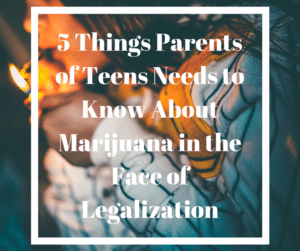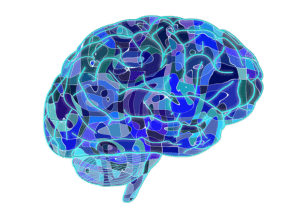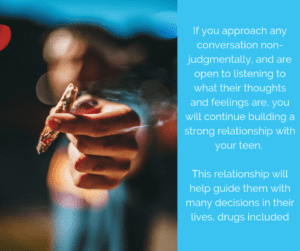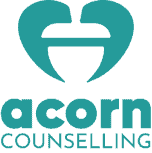
It’s a big week in Canada. The government is selling recreational cannabis, as well as pipes, bongs, and other paraphernalia. Some folks are celebrating; while others can’t believe what is going on.
Regardless of where you may stand, the changes to the marijuana laws have some parents of teens concerned.
What do I say now? Is it safe? Does this mean it is okay for them to smoke? How will this affect their choices or their future? Does this mean my teen will easily get marijuana and become a pot head, drop out of school, and flip burgers for a living?!

Legalization has been an ongoing debate for a long time. With that, there were strong positions on either side, and so a lot of myths and misinformation has been floating around. In fact, I am not even sure what the general consensus is on safety. Working with teens, I have heard so many opinions presented as facts: “It’s natural. It helps with my anxiety. It helps me focus.”
But with all the mixed messages, from “It cures cancer!” to “it causes schizophrenia”, here are 5 important things parents should know that can help you have an honest, factual conversation with your teen.
1) No, it is not “safe” for teens
There are obvious health risks associated with smoking. Smoking anything can affect the lungs, the heart, and many other organs. But the main concern with marijuana is about the brain.
The adolescent brain is not finished growing. In fact, the brain doesn’t completely finish growing until about the age of 25. Until then, the pre-frontal cortex is still developing. This region of the brain is the last to develop, and is responsible for integrating all the other parts of the brain.
The pre-frontal cortex part of the brain that is responsible for planning, thinking, imagining, empathy, sound decision-making, problem solving, impulse control and self-awareness. It helps us deal with situations that may arise in a controlled way, taking in information, analyzing it, determining how it fits with our values, recalling past experiences, evaluating different response options, and more.

Dr Dan Siegel and Dr. Jean Clinton talk about the developing brain and have brought to light the amazing changes that happen as we grow from infants to adults. The first major time for brain growth happens in the first few years of life, which lays the foundation for the years to come.
Then, during adolescents, another major remodelling happens, where old neural connections are trimmed away or strengthened, and the brain undergoes another growth spurt (one that lasts a decade).
This brain development is responsible for teens being the way they are: sometimes irritable or having a hard time controlling emotions, sleeping a lot, focusing on experiences, taking risks, and so on.
It is also during the teen years that new connections in the brain are made, and all the useful connections are strengthened. The brain determines which routes are frequently used and important, and it strengthens those paths, much like turning dirt roads into super-highways.
Where the problem lies is that marijuana (or the active chemical THC), works to slow down communication between cells in the brain. With heavy use, this may stop the brain from developing the neural pathways it needs to develop to make successful and functioning adults.
2) It stays in your system for days
The chemical compound in marijuana, known as THC, is fat-soluble. This means that it does not get easily processed through the body and instead gets stored in fatty cells. Guess which organ is full of fatty tissue? The brain! In fact the brain is about 60% fat. So to have THC absorbed into the brain is not ideal for brain development.
Then, the human body does not actually metabolize the THC very quickly, and so it can sit in the fat cells for at least 3 days. For the occasional user, it might not be the end of the world; but with more regular use, the body does not eliminate all the THC, which means that it may build up. In the brain.
The chemicals in marijuana affect the brain by slowing down communication between cells. Depending on which part of the brain is affected, because each part has a different function, you can experience changes in appetite, coordination, memory, judgment, and thinking. These effects can last for days, because the chemicals take time to be cleared out. You can find more information about the effects of marijuana in The Science of Marijuana.
3) There are major impacts on mental health and wellbeing
For the very infrequent user, whose body and brain have time to cleanse from the substance use, and who also has many other developmentally appropriate domains of life balanced (such as support, boundaries and expectations, constructive use of time, social competencies) the impact may not be too dramatic.
This is not a pro or con article. I believe that when people are empowered with the information, they can choose to do as they see fit. Free will, be it, or internal agency.
With that said, there are effects on mental health. For some regular users or any mind of mood altering substances, the reward system of the brain is impacted, which in turn changes a person’s baseline mood. This can sometimes develop into a cycle where someone may need to use more to achieve the same high, while the lows get lower.
What’s more is that if substances (including weed) are used as a coping mechanism, or as a way of avoiding problems or feelings (which can easily happen when something makes you feel good and makes you forget about other things that may be going on) then the person using will not able to develop other coping skills or ways of managing harder times.
Everyone, child youth or adult, needs coping skills for mental health and well-being. These skills can help people move through difficult times, learn from situations, and mature emotionally. This is another big reason that regular use for young people can be worrisome.
There is also growing research pointing to the link between marijuana use in young people with a family history of psychotic disorders, such as schizophrenia, and early onset of these disorders. This Globe and Mail article published earlier this year touches on some of these findings.
For a very small population, substance induced psychosis can also happen. This is a psychotic episode as a result of smoking or ingesting marijuana, however, there is still very little research and evidence about these links. There have also been people most of us know that have smoked for years and have not experienced any ill effects.
Perhaps now that cannabis is legal, the doors can open for good research that can further inform some of these concerns, and help us better understand what the benefits and risks are. If you have additional questions, speak to a local substance abuse specialist or addictions counsellor.
In the meantime, there is substantial documented risk for teens that use on a more regular basis.
4) Drug use happens on a continuum
It is helpful to think of marijuana use as on a continuum starting with not using at all. From there, it is quite typical for the teen years to bring about the experimenting phase, where it is normal for teens to try different substances in different contexts. For example, trying a beer at a party or trying a joint with friends on a weekend.
Recreational use follows, not in a clear trajectory, but in some cases teens (or adults) may start using more regularly. This regular use can have patterns and rules associated with it, such as only with friends, or not during school.
Problem use comes after on the continuum, where some of those pre-established rules are being broken and the substance use is seeping into other areas of life. This may include using at school or work, fighting with family about use, and missing or avoiding responsibilities.
On a typical continuum, from problem use you can end up in dependence or addiction,
There are no hard or fast rules about progressing through this model. The point is to think about your teen likely being exposed to and trying substances at some point, and this may be within normal adolescent development.
You (and your teen, with help) will want to determine what the function of using is. Is it to have fun? Dull feelings? Think differently or gain perspective? Get through boring tasks? To feel better? To get along with friends? Talk to your teen about what it does for them and why they choose to smoke (or ingest); it can help you and your teen figure out where on the continuum they are.
There are risks, as you can see from the above. However, if teens know the facts, they can make better choices for themselves.
If you do have concerns about your teens use, or want support, Alternatives for Youth (AY) is a great local resource that helps teens as well as parents with substance use concerns.
5) You have a role to play
I talk about informed choices in this article, because no one actually has the power or ability to control anyone else. This is true for parents of teens too.
Of course, you may have the best of intentions and worry about their choices. However, trying to “control” or approach your teen in a more authoritarian parenting style, does not work. Your teen will continue to make their own choices, and you may not know about these choices. This may actually be more risky for your teen; because if they were to get into trouble, they may not reach out to you for help.
The same goes for a more hands-off parenting approach, a more permissive style, where parents may loosen rules and expectations. The difficulty here is that young people are not adults and need some structure, guidance, and expectations.
Teens need rules. Rules that are values based help teens grow as humans. Rules also prepare them to enter the world as adults who know their limits and can follow instructions. We all need these things to be successful.
The goal is to create a trusting connection and maintain limits and expectations at the same time. That sweet spot between too strict and too lenient. It is through the relationship and connection between teens and parents that parents can be placed into a position of influence.
But influence is secondary to a relationship based on trust, mutual respect, and authentic connection.
If you have an honest, open and trusting relationship with your teen, where they feel emotionally supported and validated, then they will let you know some of what they are up against. Parents are actually the biggest influencers in a child/teen’s life.
Teens care what you think! Kids always deeply care about what their parents think, or how they see them. They likely aren’t letting you in on that. But know that what you say, think, and how you are with your child matters a great deal.

Remember that alcohol was illegal less than 100 years ago. Now when we talk about alcohol use, we talk about responsible use. It will be the same for cannabis, as it carves out its place in our culture (legally). Use responsibly if you chose to use. This message will need to be the same for teens, who have additional risk factors to consider.
So, I hope that you feel at least a little more informed and equipped to talk to your teen about marijuana. Or drugs in general.
If you approach any conversation non-judgmentally, and are open to listening to what their thoughts and feelings are, you will continue building a strong relationship with your teen. This relationship will help guide them with many decisions in their lives, drugs included.
Working with the parent-teen relationship is one of my favourite aspects of my work. Building authentic connections between parents and children is what makes families thrive. Email [email protected] if you need support in your connection with your teen. Or contact us here.





